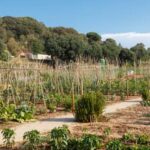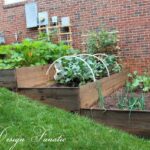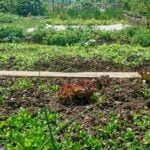Are you interested in creating a lush, vibrant oasis right in your own backyard? Look no further than the world of backyard vegetable gardens.
In this article, we will explore the many benefits of cultivating your own vegetable garden, from providing fresh and organic produce to promoting sustainability and self-sufficiency. Whether you are a seasoned gardener or a novice just dipping your toes into the soil, this guide will help you establish and maintain a thriving vegetable garden in your backyard.
One of the key advantages of backyard vegetable gardens is the ability to have easy access to fresh, nutritious produce right outside your doorstep. By growing your own vegetables, you can ensure that you and your family are consuming food that is free from harmful chemicals and pesticides. Furthermore, it offers a sense of fulfillment and satisfaction knowing that the fruits of your labor were grown with love and care.
In addition to providing healthy and delicious food options, backyard vegetable gardens also contribute to environmental sustainability by reducing the carbon footprint associated with commercial agriculture. By growing local produce, you can minimize transportation emissions and support biodiversity in your area.
Stay tuned as we delve into various aspects of establishing and maintaining a successful backyard vegetable garden, including selecting the perfect location, essential tools and supplies, choosing suitable vegetables for your climate and soil, planning the layout of your garden space, proper planting techniques, pest management, harvesting tips, and more. Join us on this journey as we embrace the joy of backyard vegetable gardens.
Selecting the Perfect Location for Your Garden
One of the most important factors in the success of your backyard vegetable garden is the location. Choosing the perfect spot can make a significant difference in the growth and yield of your plants. Ideally, your garden should receive at least 6-8 hours of direct sunlight each day. This is essential for the healthy development of most vegetables. Take note of any large trees or structures that may cast shadows over your potential garden location.
In addition to sunlight, it’s important to consider access to water. Your garden should be located within reach of a water source, whether it’s a hose or a nearby watering can. Proper drainage is also crucial to avoid waterlogging and root rot in your plants.
To test drainage, you can dig a hole and fill it with water. If it takes more than a few hours to drain, you may need to improve the soil or choose another location.
Consider proximity to your home as well. You’ll be more likely to tend to your garden regularly if it’s conveniently located near your house. This will also allow you to keep an eye on potential pests and diseases, and easily harvest fresh vegetables for meals.
Finally, take into account the microclimate of your yard. Different areas may have slightly different temperatures, wind patterns, and moisture levels due to factors such as nearby buildings or trees. Understanding these microclimates can help you select the best location for specific types of vegetables.
| Location Factors | Considerations |
|---|---|
| Sunlight | 6-8 hours per day |
| Water Access | Proximity to water source |
| Drainage | Adequate drainage essential |
Essential Tools and Supplies for Starting a Backyard Vegetable Garden
Starting a backyard vegetable garden is an exciting and rewarding endeavor, but it requires the right tools and supplies to ensure success. Here are some essential items you’ll need to get started:
- Garden Spade or Trowel: These tools are essential for digging and planting in your garden. A sturdy spade will help you break up tough soil and create planting holes, while a trowel is perfect for smaller tasks like transplanting seedlings.
- Garden Hoe: Hoes are great for removing weeds, breaking up soil, and shaping planting rows. Look for one with a sharp blade that can easily slice through the earth.
- Watering Can or Hose: Proper watering is crucial for the health of your plants, so make sure you have a reliable watering can or hose to keep your garden hydrated.
- Gardening Gloves: Protect your hands from blisters, thorns, and dirt with a sturdy pair of gardening gloves. Look for gloves that fit well and provide good grip.
In addition to these tools, there are several supplies you’ll need to have on hand when starting a backyard vegetable garden. These include:
- Quality Soil: Good soil is the foundation of a successful garden. Invest in high-quality compost or potting mix to ensure your plants have the nutrients they need to thrive.
- Seeds or Seedlings: Depending on the vegetables you want to grow, you’ll need seeds or small starter plants to get your garden going. Consider factors such as climate, sunlight, and space when selecting your vegetables.
- Fertilizer: To promote healthy growth and bountiful harvests, consider adding fertilizer to your gardening toolkit. There are many organic options available that are safe for both your plants and the environment.
By making sure you have these essential tools and supplies on hand, you’ll be well-prepared to start your own backyard vegetable garden and enjoy the benefits of growing your own fresh produce right at home.
Choosing the Right Vegetables for Your Climate and Soil
When it comes to choosing the right vegetables for your climate and soil, it’s important to consider the specific conditions of your backyard. Different vegetables thrive in different environments, so it’s essential to do some research before selecting which plants to grow. The USDA Plant Hardiness Zone Map is a useful tool for determining which plants are most likely to flourish in your area.
For those with limited space or challenging soil conditions, consider growing vegetables that are well-suited for container gardening or raised beds. Some examples of vegetables that are adaptable to various climates and soils include tomatoes, peppers, and lettuce. These versatile plants can be grown in a range of environments and are a great option for beginners.
It’s also important to consider the amount of sunlight your garden receives. Most vegetables require at least 6-8 hours of direct sunlight per day, so be sure to choose vegetables that are compatible with the amount of sunshine available in your backyard. Additionally, take into account the average temperature and rainfall in your area when selecting which vegetables to plant.
One way to ensure success in choosing the right vegetables for your climate and soil is by seeking advice from local gardening experts or visiting a nearby nursery for recommendations. They can provide valuable insight into which plants are best suited for your specific geographic region, helping you create a thriving backyard vegetable garden.
| Vegetable | Climate | Soil Type |
|---|---|---|
| Tomatoes | Adaptable | Well-draining |
| Peppers | Varies by type | Sandy loam |
| Lettuce | Cool weather | Fertile and moist |
Planning and Layout of Your Garden Space
When planning and laying out your garden space for your backyard vegetable garden, there are several important factors to consider. Here are some essential tips to help you effectively plan and organize your garden:
1. Determine the layout: Think about how much space you have available in your backyard and consider the best layout for your vegetable garden. You can opt for traditional rows or raised beds depending on the space and aesthetic you desire.
2. Consider sunlight and water access: Make sure to place your garden in a location that receives ample sunlight, as most vegetables require at least 6-8 hours of direct sunlight per day. Additionally, ensure easy access to water for irrigation purposes.
3. Companion planting: Research companion planting techniques to maximize the use of space in your garden and improve crop health. Certain plants thrive when planted together, while others benefit from being kept apart. This can also help with natural pest control.
4. Allow for pathways and access: When planning the layout of your garden, incorporate designated pathways and access points for harvesting, weeding, and maintenance. This will make it easier to navigate through the garden without compacting the soil around your plants.
By carefully considering these aspects when planning and laying out your backyard vegetable garden, you can create an organized and efficient space that will set you up for a successful growing season.
Overall, proper planning and layout are crucial elements in ensuring a thriving backyard vegetable garden that yields a bountiful harvest of fresh produce for you and your family to enjoy throughout the growing season.
Tips for Proper Planting, Watering, and Fertilizing
Springtime is an exciting time for backyard vegetable gardeners as it marks the beginning of planting season. Proper planting, watering, and fertilizing are essential steps to ensure a bountiful harvest. Here are some tips to help you get started on the right foot.
Proper Planting
When planting your vegetables, it’s important to consider the spacing between each plant to allow for proper growth. Some vegetables require more space than others, so be sure to follow the recommended spacing guidelines on the seed packets or plant labels. Additionally, pay attention to the depth at which each vegetable should be planted to promote healthy root development.
Watering
Adequate watering is crucial for the success of your backyard vegetable garden. Different vegetables have different water needs, so it’s important to research and understand the specific requirements of each type of vegetable you are growing. In general, most vegetables prefer consistent moisture but with good drainage to prevent waterlogged soil.
Fertilizing
Fertilizing your garden properly can provide essential nutrients that will support healthy plant growth and maximize your yield. Before adding any fertilizers, test your soil to determine its nutrient levels and pH balance. Based on this information, select a fertilizer that will supplement any deficiencies in your soil and follow the instructions for application carefully.
By following these tips for proper planting, watering, and fertilizing, you can set a solid foundation for a successful backyard vegetable garden. Remember that consistency is key – paying attention to these fundamental aspects of gardening will contribute greatly to the health and productivity of your plants throughout the growing season.
Managing Pests and Diseases in Your Vegetable Garden
Pests and diseases can pose a significant threat to the success of your backyard vegetable garden. However, with proper planning and vigilance, you can effectively manage these challenges and protect your precious crops. There are several strategies you can employ to minimize the impact of pests and diseases on your garden.
One of the key tactics in pest and disease management is prevention. Start by selecting disease-resistant vegetable varieties when planning your garden. Additionally, practice crop rotation from season to season to help prevent the buildup of pests and diseases in the soil. Proper spacing between plants can also improve air circulation and reduce the risk of fungal infections.
Furthermore, keeping a close eye on your plants is essential for early detection of any pest or disease issues. Inspect your plants regularly for signs of damage or infestation, such as discoloration, wilting, or unusual spots on leaves. By catching problems early, you can take timely action to address them before they become more severe and threaten your entire garden.
In addition to preventive measures, there are various natural and organic methods for controlling pests and diseases in your vegetable garden. This includes introducing beneficial insects that prey on harmful pests, using insecticidal soaps or neem oil sprays, and applying organic fungicides when necessary. By taking a proactive approach to pest and disease management, you can help ensure a bountiful harvest from your backyard vegetable gardens gardens while minimizing the need for harsh chemical treatments.
Harvesting and Enjoying the Fruits of Your Labor
Once you have put in all the hard work of planting, watering, and caring for your backyard vegetable garden, it’s time to reap the rewards of your labor. Harvesting fresh produce from your own garden can be a truly gratifying experience, and there are several factors to consider to ensure that you enjoy the fruits of your labor to the fullest.
Timing Your Harvest
One of the keys to enjoying the best flavors and nutrients from your homegrown vegetables is harvesting them at the right time. Each type of vegetable has its own ideal harvest window, so it’s important to familiarize yourself with the specific signs that indicate when they are ready for picking.
For example, tomatoes should be harvested when they are fully colored and slightly soft to the touch, while leafy greens like lettuce and spinach are best picked when they reach a certain size but before they start to bolt or turn bitter.
Proper Storage and Preservation
After harvesting your vegetables, it’s crucial to handle them properly to preserve their freshness and flavor. Some vegetables can be stored in a cool, dry place for weeks or even months, while others are best enjoyed immediately after harvesting. You may also consider preserving your surplus crop through methods such as canning, freezing, pickling, or drying. This will allow you to enjoy your homegrown produce long after the growing season has ended.
Sharing Your Bounty
If your backyard vegetable garden yields an abundance of produce, consider sharing the wealth with friends, family, neighbors, or local food banks. Sharing your homegrown vegetables not only spreads joy and goodwill but also reduces waste and fosters a sense of community. Additionally, trading produce with fellow gardeners can introduce variety into your diet and expand your gardening network. By sharing your bounty with others, you’ll spread the benefits of backyard vegetable gardens beyond just yourself.
Conclusion
In conclusion, backyard vegetable gardens offer a multitude of benefits and joys that make it a worthwhile endeavor for anyone with the space and time. Not only do these gardens provide fresh, organic produce right at your fingertips, but they also promote a sense of connection to nature and the satisfaction of growing your own food. Additionally, tending to a garden can be therapeutic and reduce stress, making it an enjoyable hobby for many.
As you embark on your journey to starting a backyard vegetable garden, remember the importance of selecting the right location, using the essential tools and supplies, and choosing the appropriate vegetables for your climate and soil. Proper planning, layout, planting, watering, and fertilizing are all crucial elements in ensuring a successful harvest. It’s also important to stay vigilant in managing pests and diseases that can threaten your plants.
Ultimately, the joy of having a backyard vegetable garden lies in the process as well as the end result. The satisfaction of watching seeds sprout into healthy plants and ultimately enjoying the fruits of your labor is incomparable. So embrace the joy of gardening and reap the rewards that come from nurturing your own little piece of nature right in your backyard.
Frequently Asked Questions
What Is a Good Layout for a Vegetable Garden?
A good layout for a vegetable garden should consider factors such as sunlight, water access, and proximity to the house. Raised beds or rows can help organize the space and make maintenance easier.
What Vegetables Can You Grow in a Backyard Garden?
In a backyard garden, you can grow a variety of vegetables such as tomatoes, peppers, lettuce, carrots, radishes, zucchini, cucumbers, spinach, and herbs like basil and parsley. It’s important to choose plants that will thrive in your specific climate and soil conditions.
How Do I Prepare My Backyard for a Vegetable Garden?
Before preparing your backyard for a vegetable garden, it’s important to test the soil to understand its composition and fertility. Clear any existing vegetation, loosen the soil with a tiller or garden fork, add organic matter like compost or aged manure, and create raised beds or rows for planting. Planning for proper irrigation is also crucial.

If you’re looking to get into vegetable gardening, or are just looking for some tips on how to make your current garden better, then you’ve come to the right place! My name is Ethel and I have been gardening for years. In this blog, I’m going to share with you some of my best tips on how to create a successful vegetable garden.





